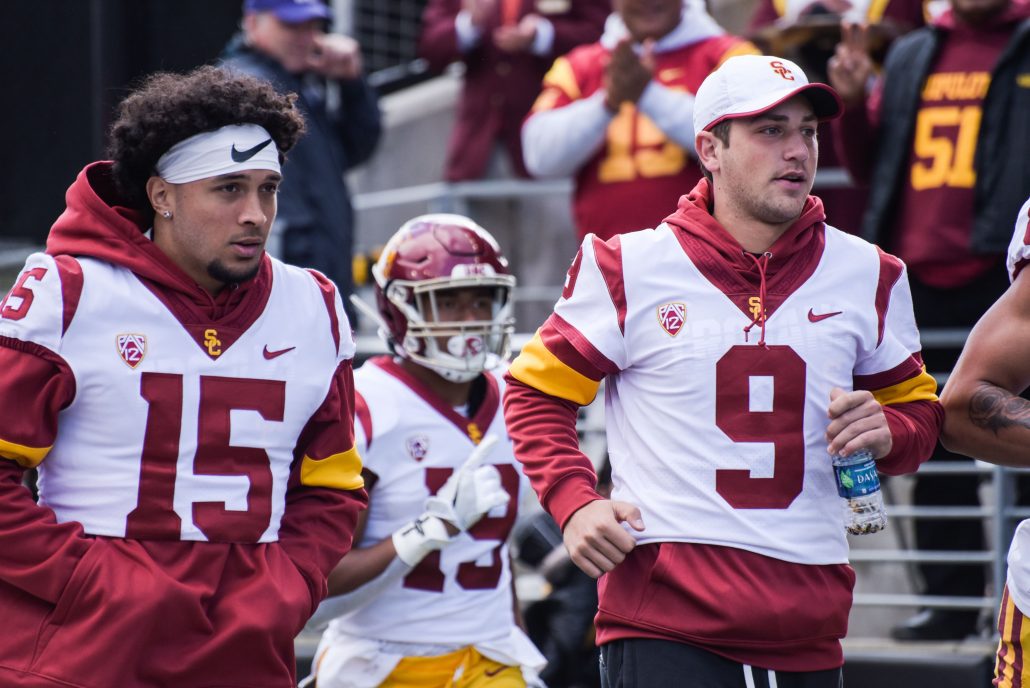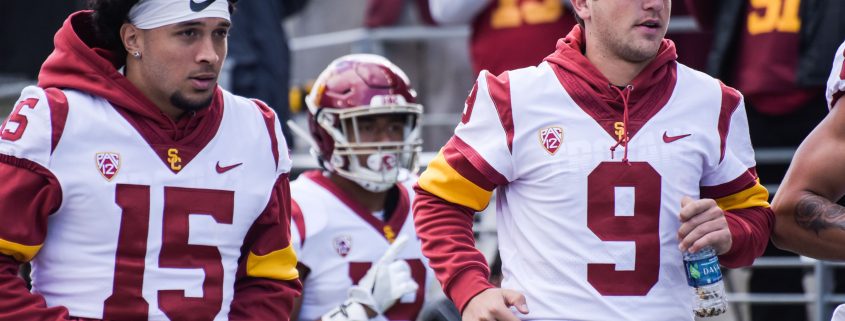USC football could use some consistency

This year’s USC football team can be summed up in a single word: unpredictable. The Trojans have bounced in and out of the AP Top 25, winning games against Stanford and Utah they were expected to lose and conceding a game against non-conference BYU they were heavily favored to win. Now that USC has a bye week to prepare for No. 9 Notre Dame, let’s reflect on what has gone well, what has gone poorly and what we can look forward to seeing from the Trojans in the coming weeks.
What’s gone well:
Air Raid offense (for the most part)
Offensive coordinator Graham Harrell’s Air Raid scheme has been a positive change for a Trojan offense ranked 91st in points scored in 2018. The pass-heavy strategy highlights the Trojans’ talent at wide receiver and has resulted in some big performances, including senior wide receiver Michael Pittman Jr.’s 232-yard outing against Utah. While the game plan fell a little short against Washington as USC’s offense relied on short passes and runs rather than deep balls, overall the Air Raid scheme has allowed the Trojan offense to shock its opponents with its quick tempo.
Young defense stepping up
Sophomores safety Talanoa Hufanga and cornerback Olaijah Griffin sat out last Saturday against Washington due to injury, while redshirt sophomore cornerback Greg Johnson was benched for the first quarter due to violation of a team rule. Despite the absence of these starters, the Trojan defense was able to keep USC within striking distance of Washington. Freshman cornerback Max Williams, who played in Johnson’s place, forced a fumble just before the goal line that was recovered by the Huskies for a score. In the fourth quarter, freshman cornerback Chris Steele recovered a fumble in Washington territory, handing the Trojans a chance to close the gap. The Trojans’ defensive depth is promising, especially as they counter a Notre Dame offense which put up 52 unanswered points against Bowling Green Saturday.
What’s gone poorly:
Inexperienced starters playing on the road
We saw it with freshman quarterback Kedon Slovis in his second start against BYU, and we saw it again with redshirt junior quarterback Matt Fink in his first nod at Washington: Playing on the road is tough for Trojan backups. Slovis’s rocky start at BYU came after a breakout performance against Stanford in which he completed 84.8% of his passes for 377 yards and three touchdowns. However, Slovis’ road debut was marred by three interceptions, two of which gave BYU the ball well into Trojan territory.
After Slovis went down on just the second play of USC’s game against then-No. 10 Utah, Fink stepped up to the challenge. He threw for 351 yards, three touchdowns and just one interception en route to victory that would have been unexpected even if the Trojans weren’t on their third-string quarterback. The following week at Washington, Fink’s passing game was all but shut down as he threw for just 163 yards and three costly picks.
Whoever the starter is this upcoming game will need to minimize these errors against an unforgiving Notre Dame defense to give the Trojans a chance to outpace the Fighting Irish.
Slow offensive starts
The Trojan defense has kept USC in games, but the offense needs to get off to quicker starts to give USC a chance to outscore top offensive opponents including Notre Dame and Oregon. The Trojans average just 7.6 points in the first quarter this season — mediocre next to Notre Dame’s 11.2 point average to start out games. Notre Dame is 11th in the nation with 41 points per game, so the Trojans must begin quickly Saturday to have a chance at outpacing the Fighting Irish.
What to look forward to:
Getting healthy
In last week’s 28-14 loss at Washington, the Trojans were missing Slovis, Hufanga and Griffin. Slovis and Hufanga, both recovering from concussions, have been cleared to practice without contact, while Griffin has returned to practice and is expected to start against Notre Dame Saturday. The ability of the Trojan secondary to recover during the bye week is significant as it faces senior quarterback Ian Book, who has a 13 to 2 touchdown-to-interception ratio this season. Slovis’ health also remains a concern heading into another road game given Fink’s less-than-stellar performance at Washington last weekend.
Mixing up the pass and run
Notre Dame has a versatile defense with the ability to create turnovers both at the line and against the pass. Given that Notre Dame has six interceptions and seven forced fumbles through five games, the Trojans cannot afford to be predictable and rely too heavily on the passing game. USC has a stacked backfield including junior Stephen Carr, redshirt junior Vavae Malepeai and redshirt freshman Markese Stepp and must mix in the run game to open up the lanes for its talented receivers. The Trojans can’t repeat the mistake they made against Washington of throwing mainly short routes and not allowing their receivers the opportunity to make contested deep catches. A balance between the pass and run is required to put the pressure on a Notre Dame defense, which is prepared to counter both sides of the game.
Ultimately, the Trojans’ success in the tail end of the season will come down to consistency.

